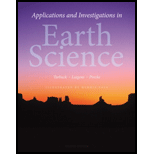
Applications and Investigations in Earth Science (8th Edition)
8th Edition
ISBN: 9780321934529
Author: Edward J. Tarbuck, Frederick K. Lutgens, Dennis G. Tasa, Kenneth G. Pinzke
Publisher: PEARSON
expand_more
expand_more
format_list_bulleted
Textbook Question
Chapter 11.5B, Problem 8A
What feature indicates that the headland called Point Reyes recently been uplifted?
_________
Expert Solution & Answer
Learn your wayIncludes step-by-step video

schedule03:44
Chapter 11 Solutions
Applications and Investigations in Earth Science (8th Edition)
Ch. 11.1 - Prob. 1ACh. 11.1 - Prob. 2ACh. 11.2 - Prob. 1ACh. 11.2 - Near the shore in shallow water, do water...Ch. 11.2 - In shallow water, are water particles in the wave...Ch. 11.2 - As waves approach the shore, do their heights...Ch. 11.2 - In the surf zone, is the water in the crest of a...Ch. 11.2 - Prob. 6ACh. 11.2 - Prob. 7ACh. 11.2 - Prob. 8A
Ch. 11.2 - What two factors determine how far from the...Ch. 11.2 - Imagine that you are standing on a beach but...Ch. 11.2 - Along some shorelines, incoming waves cause the...Ch. 11.2 - One type of ocean wave, call a tsunami, is usually...Ch. 11.3 - Prob. 1ACh. 11.3 - At approximately what water depth- 3, 6, 12, or 24...Ch. 11.3 - Prob. 4ACh. 11.3 - Will wave erosion be most severe on the headland...Ch. 11.3 - What effect will the concentrated energy from wave...Ch. 11.4 - Prob. 1ACh. 11.4 - Name three shoreline features that are produced,...Ch. 11.4 - Prob. 3ACh. 11.4 - Prob. 4ACh. 11.5A - Prob. 1ACh. 11.5A - Next to each of the features listed below,...Ch. 11.5A - Prob. 3ACh. 11.5A - Prob. 4ACh. 11.5A - Prob. 5ACh. 11.5B - Prob. 1ACh. 11.5B - Point Reyes, located in the bottom-left corner of...Ch. 11.5B - Several depositional features near Drakes Estero...Ch. 11.5B - Follow Limantour Spit from its western tip at the...Ch. 11.5B - What geologic feature is Estero de Limantour?Ch. 11.5B - Limantour Spit may eventually extend across the...Ch. 11.5B - Locate the bench mark BM with an elevation of 552...Ch. 11.5B - What feature indicates that the headland called...Ch. 11.5B - List at least two features on the map that are...Ch. 11.6 - Prob. 1ACh. 11.6 - Which surface-ocean current travels completely...Ch. 11.6 - Which surface-ocean current flows along the...Ch. 11.6 - What is the name of the surface-ocean current...Ch. 11.6 - Is the general circulation of the surface currents...Ch. 11.6 - In the South Atlantic, is the general circulation...Ch. 11.7 - Prob. 1ACh. 11.7 - What process causes the Mediterranean intermediate...Ch. 11.7 - Prob. 3ACh. 11.7 - Assume that water sinking in the North Atlantic...Ch. 11.8A - Prob. 1ACh. 11.8A - Write the word spring or neap above the period of...Ch. 11.8A - Which coastal area experiences the largest tidal...Ch. 11.8A - Which coastal area experiences the smallest tidal...Ch. 11.8A - Prob. 5ACh. 11.8B - Prob. 1ACh. 11.8B - Prob. 2ACh. 11.8C - Prob. 1ACh. 11.8C - Prob. 2ACh. 11.8C - Prob. 3ACh. 11.8C - Prob. 4ACh. 11.8C - Prob. 5ACh. 11 - Prob. 1LRCh. 11 - What happens to wavelength and wave height as a...Ch. 11 - Prob. 3LRCh. 11 - Is the circulation of the surface-ocean currents...Ch. 11 - Prob. 5LRCh. 11 - Explain what causes spring tides.Ch. 11 - Prob. 7LRCh. 11 - Prob. 8LRCh. 11 - Prob. 9LR
Additional Science Textbook Solutions
Find more solutions based on key concepts
Saturation mixing ratio?
Exercises for Weather & Climate (9th Edition)
The number of electrons, protons and neutrons of gadolinium atom having atomic number 64 and mass number 153 ne...
Chemistry: Matter and Change
Show that E2=p2c2+m2c4 follows from expressions (2-22) and (2-24) for momentum and energyin terms of m and u.
Modern Physics
Figure P3.58
3.58 Kicking an Extra Point. In Canadian football, after a touchdown the team has the opportunity...
University Physics (14th Edition)
Q2. This image represents a particulate view of a sample of matter. Classify the sample according to its compos...
Chemistry: A Molecular Approach (4th Edition)
Knowledge Booster
Recommended textbooks for you
 Applications and Investigations in Earth Science ...Earth ScienceISBN:9780134746241Author:Edward J. Tarbuck, Frederick K. Lutgens, Dennis G. TasaPublisher:PEARSON
Applications and Investigations in Earth Science ...Earth ScienceISBN:9780134746241Author:Edward J. Tarbuck, Frederick K. Lutgens, Dennis G. TasaPublisher:PEARSON Exercises for Weather & Climate (9th Edition)Earth ScienceISBN:9780134041360Author:Greg CarbonePublisher:PEARSON
Exercises for Weather & Climate (9th Edition)Earth ScienceISBN:9780134041360Author:Greg CarbonePublisher:PEARSON Environmental ScienceEarth ScienceISBN:9781260153125Author:William P Cunningham Prof., Mary Ann Cunningham ProfessorPublisher:McGraw-Hill Education
Environmental ScienceEarth ScienceISBN:9781260153125Author:William P Cunningham Prof., Mary Ann Cunningham ProfessorPublisher:McGraw-Hill Education Earth Science (15th Edition)Earth ScienceISBN:9780134543536Author:Edward J. Tarbuck, Frederick K. Lutgens, Dennis G. TasaPublisher:PEARSON
Earth Science (15th Edition)Earth ScienceISBN:9780134543536Author:Edward J. Tarbuck, Frederick K. Lutgens, Dennis G. TasaPublisher:PEARSON Environmental Science (MindTap Course List)Earth ScienceISBN:9781337569613Author:G. Tyler Miller, Scott SpoolmanPublisher:Cengage Learning
Environmental Science (MindTap Course List)Earth ScienceISBN:9781337569613Author:G. Tyler Miller, Scott SpoolmanPublisher:Cengage Learning Physical GeologyEarth ScienceISBN:9781259916823Author:Plummer, Charles C., CARLSON, Diane H., Hammersley, LisaPublisher:Mcgraw-hill Education,
Physical GeologyEarth ScienceISBN:9781259916823Author:Plummer, Charles C., CARLSON, Diane H., Hammersley, LisaPublisher:Mcgraw-hill Education,

Applications and Investigations in Earth Science ...
Earth Science
ISBN:9780134746241
Author:Edward J. Tarbuck, Frederick K. Lutgens, Dennis G. Tasa
Publisher:PEARSON

Exercises for Weather & Climate (9th Edition)
Earth Science
ISBN:9780134041360
Author:Greg Carbone
Publisher:PEARSON

Environmental Science
Earth Science
ISBN:9781260153125
Author:William P Cunningham Prof., Mary Ann Cunningham Professor
Publisher:McGraw-Hill Education

Earth Science (15th Edition)
Earth Science
ISBN:9780134543536
Author:Edward J. Tarbuck, Frederick K. Lutgens, Dennis G. Tasa
Publisher:PEARSON

Environmental Science (MindTap Course List)
Earth Science
ISBN:9781337569613
Author:G. Tyler Miller, Scott Spoolman
Publisher:Cengage Learning

Physical Geology
Earth Science
ISBN:9781259916823
Author:Plummer, Charles C., CARLSON, Diane H., Hammersley, Lisa
Publisher:Mcgraw-hill Education,